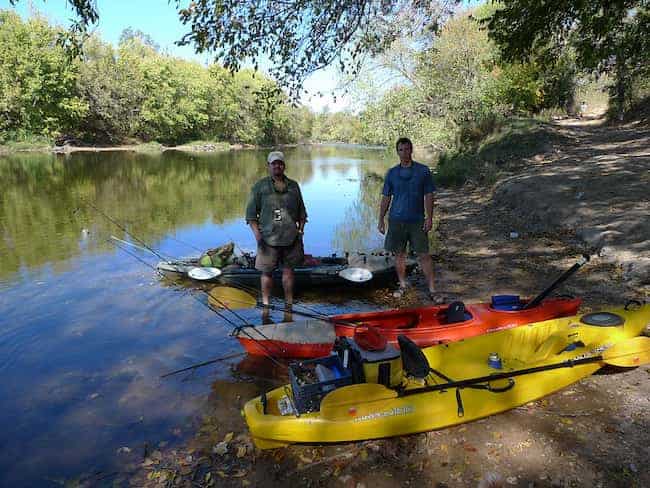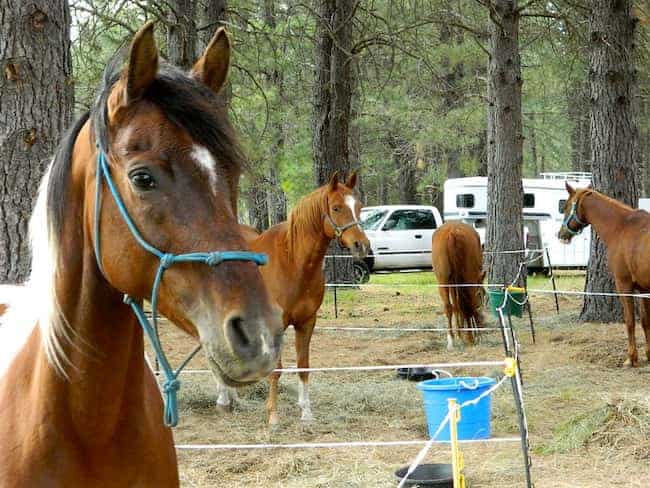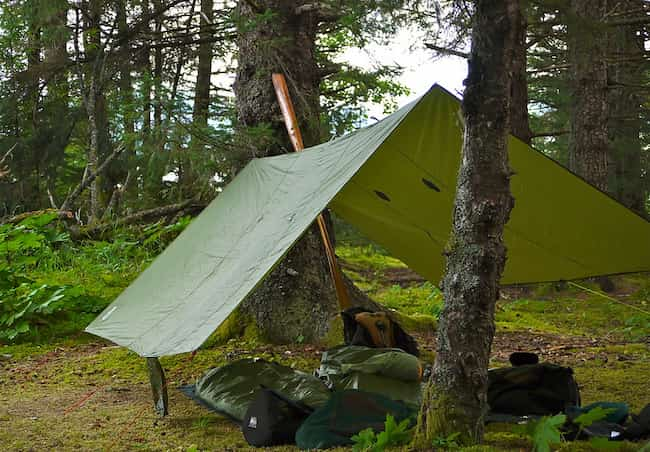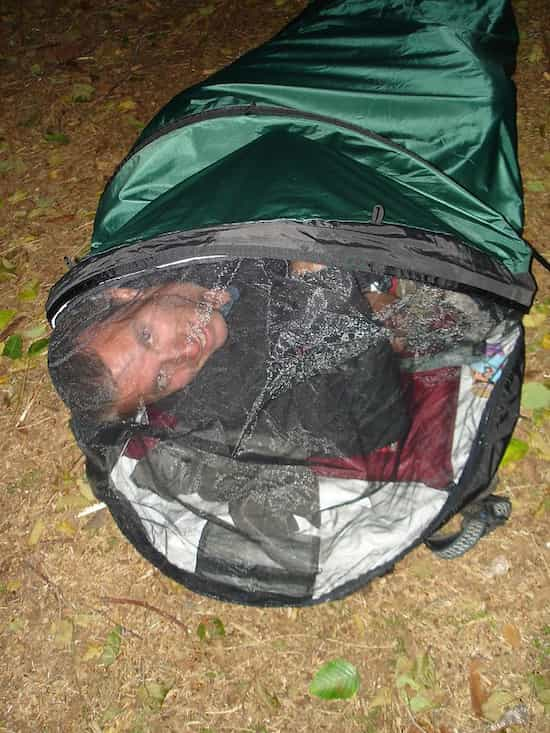Camping is a simple word that encompasses a world of possibilities! It’s all about packing up your essentials, heading out to a serene spot, and embracing the wonders of nature. Personally, just sitting alone in a small forest near my home is enough to call it a successful camping. People label camping primarily with tents but In my expertise camping stands for more than that.
I want to give you a rundown of 16 incredible types of camping that will undoubtedly enrich your life and deepen your connection with nature. In the following sections, we’ll dive deep into each camping style, offering tips, expert guidance, and captivating tales from personal experiences.
So, grab a comfy seat, and feel free to use the table of contents to navigate the various sections. Let’s begin our journey into the wild and wonderful world of camping!
22 Types Of Camping Summarized in a Table:
If you don’t have time to read the article due to time issues, I have curated a simple table that will give you a simple description of all camping types that are epic and unique. You can scroll through the article to learn more about a specific type of camping or use the table of contents listed above.
| Camping Type | Description |
|---|---|
| Traditional Tent Camping | Classic camping experience with tents as primary shelter |
| Backpacking/Hiking Camping | Camping while trekking through nature |
| RV and Van Camping | Camping in recreational vehicles or vans |
| Glamping | Luxury camping with high-end amenities |
| Bikepacking | Cycling and camping combined for adventurous travel |
| Hammock Camping | Camping in a suspended hammock for a comfortable experience |
| Adventure Camping | Combining camping with exciting outdoor activities |
| Backyard Camping | Camping in your own backyard for a quick getaway |
| Canoe/Kayak Camping | Water-based camping with canoe or kayak as primary transport |
| Survival Camping | Testing survival skills in the wilderness with limited gear |
| Horse Camping | Camping while riding horses for a unique experience |
| Car Camping | Convenience of vehicle camping with access to the outdoors |
| Bouldering and Climbing Camping | Camping while climbing or bouldering adventures |
| Winter Camping | Camping in the snow and embracing the cold |
| Tarp Camping | Minimalist camping with just a tarp for shelter |
| Bivy Sack Camping | Ultra-lightweight camping with a bivy sack as primary shelter |
| Motorcycle Camping | Exploring the outdoors on a motorcycle while camping |
| Beach Camping | Camping by the beach with access to water activities |
| Dry Camping | Camping with no access to amenities like water or electricity |
| Indoor Camping | Camping indoors for a unique experience |
| Festival Camping | Camping at festivals with music, arts, and entertainment |
1. Traditional Tent Camping

a. What is traditional tent camping?
Traditional tent camping is the most common and widely recognized form of camping, where campers set up a tent at a designated campsite and spend one or more nights outdoors. This type of camping often takes place in established campgrounds, which may offer various amenities such as restrooms, showers, and fire rings.
b. Essential gear and equipment
To make the most of your tent camping experience, you’ll need some essential gear and equipment:
- Tent: Choose a tent with enough space for you and your companions, and consider factors like weather resistance, weight, and ease of setup.
- Sleeping bags and pads: Select a sleeping bag suitable for your desired temperature range, and use a sleeping pad for insulation and comfort.
- Cooking gear: A portable camping stove or a campfire (where allowed) will help you prepare meals. Don’t forget pots, pans, utensils, and a cooler for perishables.
- Lighting: Bring headlamps or lanterns to illuminate your campsite at night.
- First aid kit: Pack a well-stocked first aid kit to address any minor injuries or health issues that may arise.
c. Selecting the perfect campsite
When choosing a campsite, consider these factors:
- Accessibility: Ensure your campsite is reachable by your chosen mode of transportation.
- Ground conditions: Look for a flat, well-drained area free from rocks and roots.
- Proximity to water: Campsites near a water source is ideal for cooking, cleaning, and hydration, but avoid camping too close to avoid attracting insects and wildlife.
- Shade and wind protection: Seek a site with natural shelter from the sun and wind, such as under trees or near large rocks.
d. Safety tips and considerations
Follow these guidelines to ensure a safe and enjoyable tent camping experience:
- Adhere to campfire safety rules and never leave a fire unattended.
- Secure your food and scented items to deter wildlife from entering your campsite.
- Familiarize yourself with the area’s wildlife and plants, avoiding dangerous or poisonous species.
- Check weather forecasts before your trip and be prepared for unexpected weather changes.
Now that we’ve covered traditional tent camping let’s explore more unique and adventurous types of camping!
2. Backpacking / Hiking Camping
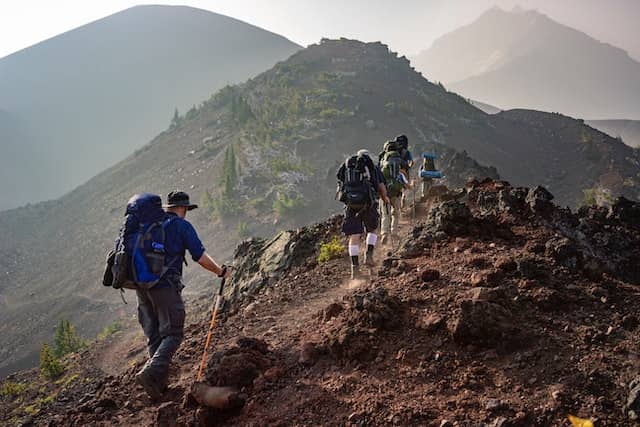
a. What is backpacking camping?
Backpacking camping combines hiking with overnight stays in the backcountry, allowing adventurers to explore remote and scenic trails. This self-sufficient camping style requires carrying all your gear, food, and shelter in a backpack, making lightweight and efficient packing essential.
b. Planning your backpacking adventure
To plan a successful backpacking trip, consider the following steps:
- Choose a destination: Research and select a trail that matches your fitness level, desired scenery, and time constraints.
- Obtain permits: Some trails require permits or reservations, so check the regulations beforehand.
- Plan your route: Study maps and guidebooks to determine your daily mileage, water sources, and potential campsite locations.
c. Essential gear and equipment
For a comfortable and safe backpacking experience, pack the following items:
- Lightweight backpacking tent or shelter
- Compact sleeping bag and pad
- Backpacking stove and cookware
- Multi-day food supply and water treatment system
- Navigation tools like maps, compass, and GPS
- Lightweight clothing layers and rain gear
- Emergency and survival gear, such as a first aid kit, whistle, and headlamp
d. Leave No Trace principles
To minimize your impact on the environment, adhere to Leave No Trace principles:
- Plan ahead and prepare: Obtain permits, follow regulations, and pack appropriate gear.
- Travel and camp on durable surfaces: Stick to established trails and campsites.
- Dispose of waste properly: Pack out all trash and human waste, and wash dishes away from water sources.
- Leave what you find: Do not pick plants, disturb wildlife, or remove natural and cultural artifacts.
- Minimize campfire impact: Use a camp stove or established fire rings, and burn only small sticks.
- Respect wildlife: Observe animals from a distance and store food securely.
- Be considerate of other visitors: Keep noise levels low and respect other campers’ privacy.
e. Popular backpacking trails and destinations
Some iconic backpacking trails and destinations in the U.S. include:
- The Appalachian Trail, spanning 2,190 miles from Georgia to Maine
- The Pacific Crest Trail, a 2,650-mile route from Mexico to Canada
- The John Muir Trail, a 211-mile journey through the High Sierra in California
- The Teton Crest Trail, offering stunning views in Wyoming’s Grand Teton National Park
Now let’s move on to a more modern and comfortable camping experience: RV and van camping!
3. RV and Van Camping
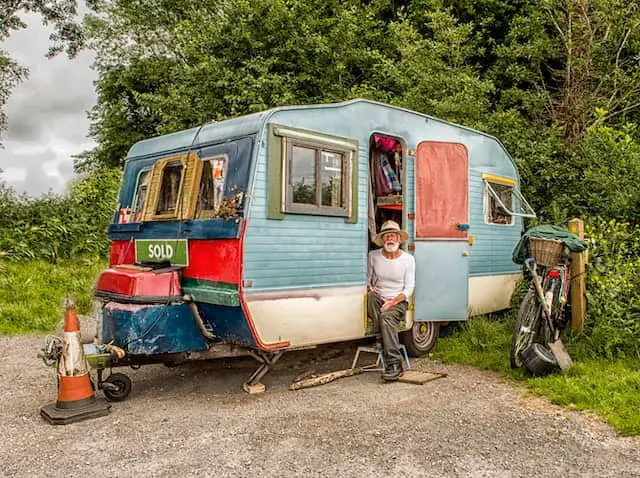
a. The world of recreational vehicles and van camping
RV (recreational vehicle) and van camping combine the comforts of home with the freedom to explore the great outdoors. This type of camping involves traveling in a vehicle equipped with sleeping quarters, a kitchen, and often a bathroom, providing a more convenient and luxurious way to camp.
b. Types of RVs and vans suitable for camping
There’s a wide range of vehicles suitable for camping, including:
- Class A, B, and C motorhomes: These self-contained RVs offer various levels of luxury and space, with Class A being the largest and most well-equipped.
- Travel trailers: Towable campers come in various sizes and layouts, providing flexibility for different travel needs.
- Camper vans and conversion vans: Smaller and more maneuverable than motorhomes, these vehicles are often custom-built or modified to include sleeping and cooking facilities.
c. Essential gear and equipment
In addition to the built-in amenities of your RV or van, you’ll need to pack:
- Power sources: Extension cords, adapters, and a generator for electricity at campsites without hookups.
- Water hoses and filters: For connecting to water sources and maintaining a clean water supply.
- Leveling blocks and chocks: To stabilize and level your vehicle on uneven terrain.
- Outdoor furniture: Chairs, tables, and a portable grill to create a comfortable outdoor living space.
d. RV park and campsite etiquette
Follow these guidelines for a pleasant RV or van camping experience:
- Adhere to campground rules and regulations, including quiet hours and pet policies.
- Respect the privacy and space of neighboring campers.
- Properly dispose of waste, using designated dump stations for black and gray water tanks.
e. Tips for maintaining your RV or van
Regular maintenance will ensure your vehicle remains reliable and enjoyable:
- Check tire pressure, fluid levels, and battery health before each trip.
- Inspect the roof and seals for leaks and repair them promptly.
- Keep the interior clean and organized to prevent pests and maintain a pleasant living space.
Next, let’s delve into the world of luxury camping with glamping!
4. Glamping: Luxury Camping in Style

a. What is glamping and its origin
Glamping, a fusion of “glamorous” and “camping,” is a trend that offers the beauty and adventure of camping with the comfort and luxury of upscale accommodations. Glamping traces its roots back to the extravagant safari camps of the early 20th century and has since evolved into a popular way to experience nature without sacrificing modern amenities.
b. Types of glamping accommodations
Glamping accommodations come in a variety of unique styles, including:
- Safari tents: Spacious canvas tents with comfortable beds, furniture, and often en-suite bathrooms.
- Yurts: Circular, semi-permanent structures with wooden frames offer a cozy and spacious living area.
- Treehouses: Elevated dwellings nestled among the trees, providing a whimsical and immersive experience.
- Airstream trailers: Retro-chic aluminum trailers with stylish interiors and modern amenities.
- Tipis and bell tents: Large, conical, or bell-shaped tents with ample room for sleeping and lounging.
c. Popular glamping destinations around the world
Glamping has become popular worldwide, with notable destinations such as:
- Big Sur, California: Breathtaking coastal views and a range of luxury tent and yurt options.
- The Serengeti, Tanzania: Experience the majesty of African wildlife from the comfort of a high-end safari camp.
- The Australian Outback: Enjoy the rugged beauty of the desert landscape while staying in luxurious tented accommodations.
- Patagonia, Chile: Immerse yourself in the dramatic landscapes of South America from the comfort of a geodesic dome or eco-lodge.
d. Amenities and activities offered in glamping resorts
Glamping resorts often provide a variety of upscale amenities and activities, such as:
- Gourmet dining experiences with locally-sourced ingredients
- Spa treatments and wellness programs
- Guided excursions like hiking, wildlife safaris, or wine tasting
- On-site activities like yoga, cooking classes, or stargazing
e. Tips for choosing the perfect glamping experience
To find the ideal glamping experience, consider factors like:
- Location and scenery: Choose a destination that matches your interests and desired level of remoteness.
- Accommodation type: Select a glamping structure that appeals to your taste and provides the desired comfort level.
- Budget: Glamping experiences can range from budget-friendly to ultra-luxurious, so consider your budget when deciding.
- Activities and amenities: Ensure the glamping resort offers activities and services that align with your interests and preferences.
Now let’s explore a more active form of camping with bikepacking!
5. Bikepacking: Combining Cycling and Camping
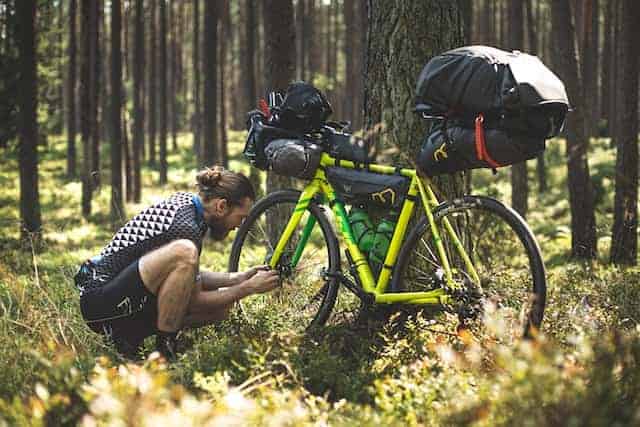
a. What is bikepacking?
Bikepacking is an adventurous blend of camping and long-distance cycling, allowing enthusiasts to explore off-the-beaten-path routes and immerse themselves in nature. This self-supported camping style involves carrying all necessary gear, food, and equipment on your bike while traversing diverse landscapes and terrains.
b. Planning your bikepacking adventure
To plan a successful bikepacking trip, consider these steps:
- Choose a route: Research and select a route that suits your fitness level, time constraints, and desired scenery.
- Train and prepare: Build up your endurance and cycling skills by gradually increasing your ride distances and practicing on varied terrain.
- Familiarize yourself with the local environment: Learn about the weather, wildlife, and any potential hazards you may encounter on your chosen route.
c. Essential gear and equipment
For a successful bikepacking trip, you’ll need the following gear and equipment:
- A suitable bike: Select a bike appropriate for your chosen terrain, such as a mountain bike for off-road routes or a touring bike for pavement and gravel.
- Bikepacking bags: Invest in specially designed bags, such as handlebar rolls, frame bags, and seat packs, to efficiently carry your gear.
- Lightweight camping gear: Choose compact and lightweight tents, sleeping bags, and cookware to minimize the weight and bulk on your bike.
- Repair and maintenance tools: Bring essential bike tools, spare tubes, and a pump to address any mechanical issues that may arise.
- Navigation tools: Pack maps, a compass, and a GPS device to help you stay on track and locate campsites or water sources.
d. Bikepacking tips and techniques
Follow these tips for a smoother bikepacking experience:
- Distribute weight evenly: Balance the weight of your gear across your bike to improve stability and handling.
- Test your setup: Experiment with different bag configurations and take test rides to ensure your bike handles well with the added load.
- Stay flexible: Be prepared to adapt your plans to changing conditions, such as weather or trail conditions, and listen to your body’s needs.
e. Popular bikepacking routes and destinations
Some iconic bikepacking routes and destinations in the U.S. include:
- The Great Divide Mountain Bike Route: A challenging 2,768-mile journey along the Continental Divide from Canada to Mexico.
- The Oregon Outback: A 364-mile route traversing the diverse landscapes of eastern Oregon, from high desert to lush forests.
- The Colorado Trail: A 539-mile epic ride through the Rocky Mountains, featuring rugged singletrack and stunning vistas.
Next up, let’s discover the unique world of hammock camping!
6. Hammock Camping: A Comfortable Alternative to Tent Camping
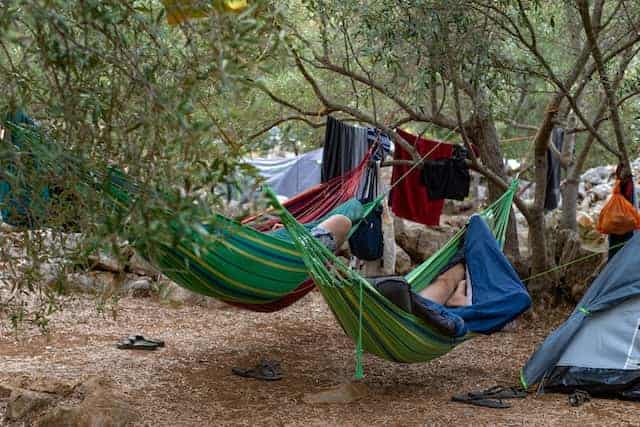
a. What is hammock camping?
Hammock camping is an alternative to traditional tent camping that involves suspending a hammock between two trees or sturdy anchor points. This form of camping offers numerous advantages, such as increased comfort, reduced environmental impact, and adaptability to uneven or sloping terrain.
b. Choosing the right hammock for camping
When selecting a hammock for camping, consider the following factors:
- Material: Opt for a durable and lightweight fabric, such as nylon, to provide strength and weather resistance.
- Size: Choose a double hammock for extra space and comfort, even if you’re camping solo.
- Suspension system: Look for an adjustable and easy-to-use suspension system, like tree straps or whoopie slings, to ensure a secure and comfortable hang.
- Accessories: Consider investing in a bug net and rain tarp to protect yourself from insects and inclement weather.
c. Setting up your hammock camping site
Follow these guidelines to set up your hammock camping site:
- Select suitable trees: Look for healthy, sturdy trees spaced about 12-15 feet apart and at least 6 inches in diameter.
- Hang your hammock: Attach your suspension system to the trees at about head height, aiming for a 30-degree angle from the horizontal to achieve a comfortable sag.
- Add insulation: Use an under quilt or sleeping pad to insulate your hammock and stay warm during the night.
- Set up your tarp: Rig your rain tarp above your hammock to provide shelter from the elements.
d. Tips for a comfortable night’s sleep
Ensure a restful night’s sleep in your hammock by following these tips:
- Lie diagonally: Position your body at a slight angle to achieve a flatter and more ergonomic sleeping position.
- Use a pillow: Bring a small camping pillow or stuff a spare clothing item into a stuff sack to support your head and neck.
- Dress appropriately: Wear warm, moisture-wicking sleepwear and use a top quilt or sleeping bag to stay cozy.
e. Responsible hammock camping practices
To minimize your impact on the environment while hammock camping, adhere to these principles:
- Use tree-friendly straps: Select wide, flat straps to protect the bark and prevent tree damage.
- Camp at established sites: Whenever possible, camp in designated areas to reduce your impact on vegetation and wildlife.
- Follow Leave No Trace principles: As with any camping, practice responsible and sustainable camping habits to preserve the environment for future generations.
Now that we’ve explored hammock camping let’s dive into the exciting realm of adventure camping! Or you can deep dive into hammock camping by reading our 101 beginners guide.
7. Adventure Camping: Exploring the Outdoors through Exciting Activities
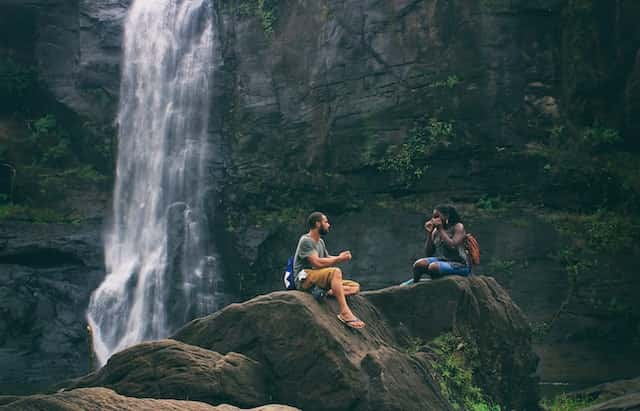
a. What is adventure camping?
Adventure camping combines the joys of outdoor exploration with thrilling activities such as rock climbing, whitewater rafting, or mountain biking. This type of camping allows enthusiasts to immerse themselves in nature while participating in adrenaline-pumping pursuits.
b. Types of adventure camping
Some popular adventure camping options include:
- Climbing and mountaineering: Camp at the base of epic climbing routes or on high-alpine ledges during multi-day ascents.
- Whitewater rafting and kayaking: Embark on a multi-day river journey, camping along the banks each night.
- Mountain biking: Ride challenging trails and camp along the way to experience remote landscapes and exhilarating descents.
- Caving and spelunking: Explore the mysterious underground world and camp in or near caves for a truly unique experience.
c. Essential gear and equipment
In addition to traditional camping gear, you’ll need specialized equipment depending on your chosen adventure:
- Climbing: Harness, helmet, rope, carabiners, and other protection devices.
- Whitewater rafting and kayaking: Personal flotation device, paddle, helmet, and dry bags.
- Mountain biking: Bike helmet, gloves, repair kit, and hydration system.
- Caving and spelunking: Helmet, headlamp, knee and elbow pads, and appropriate footwear.
d. Safety considerations for adventure camping
To ensure a safe and enjoyable adventure camping experience, follow these guidelines:
- Research and plan: Familiarize yourself with the specific hazards and challenges of your chosen activity and route.
- Acquire the necessary skills: Seek proper training and develop the required skills for your adventure before embarking on your trip.
- Travel with a partner or group: Adventure camping often involves increased risk, so it’s essential to have a buddy or team to share responsibilities and offer assistance in case of emergency.
- Monitor weather conditions: Keep an eye on the forecast and be prepared to adjust your plans if necessary.
- Carry communication devices: Bring a cell phone, satellite phone, or personal locator beacon to stay connected and call for help if needed.
e. Popular adventure camping destinations
Discover some of the world’s most iconic adventure camping destinations:
- Yosemite National Park, California: Renowned for its rock climbing routes, such as El Capitan and Half Dome, as well as its backpacking trails and waterfalls.
- The Grand Canyon, Arizona: Experience the immense beauty of this natural wonder by rafting down the Colorado River or hiking its challenging trails.
- Moab, Utah: A mountain biking paradise with famous trails like The Whole Enchilada and Slickrock and access to world-class rock climbing and river rafting.
- Banff National Park, Canada: Explore the Canadian Rockies by mountaineering, hiking, or skiing while camping amidst stunning alpine scenery.
8. Backyard Camping: A Fun and Accessible Option
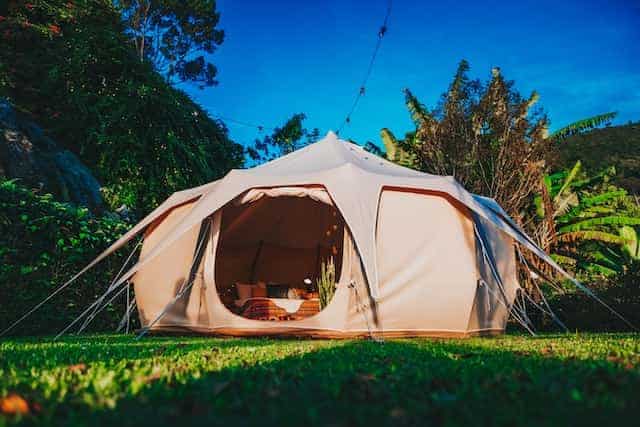
a. What is backyard camping?
Backyard camping is a simple and convenient way to enjoy the pleasures of camping without leaving the comfort of your own property. Ideal for families with young children, those new to camping, or those looking for a low-key outdoor experience, backyard camping offers a fun and accessible introduction to sleeping under the stars.
b. Benefits of backyard camping
Some advantages of backyard camping include:
- Ease and convenience: No need to pack and travel long distances, making it a stress-free option.
- Cost-effective: Save money on campsite fees, fuel, and travel expenses.
- Safety and comfort: Enjoy the familiarity of your home environment while still experiencing the outdoors.
- Test your gear: Use backyard camping as an opportunity to test new camping equipment before taking it on more extensive trips.
c. Tips for a successful backyard camping experience
To create a memorable backyard camping adventure, consider these tips:
- Set up a dedicated camping area: Choose a flat, comfortable spot in your yard and pitch your tent or hang your hammock, creating a cozy space for your outdoor slumber.
- Cook outside: Embrace the full camping experience by cooking your meals on a camp stove or grilling outdoors.
- Plan fun activities: Organize games, a scavenger hunt, or a backyard nature walk to keep everyone entertained.
- Build a campfire: If local regulations and space allow, create a small campfire for roasting marshmallows, sharing stories, and enjoying the warmth of the flames.
- Disconnect: Encourage everyone to leave their electronic devices inside and focus on connecting with nature and each other.
9. Canoe/Kayak Camping: Exploring Water-Based Camping Adventures
a. Exploring water-based camping adventures
Canoe and kayak camping offers a unique way to explore the great outdoors, combining the peacefulness of paddling with the excitement of camping. This type of camping allows you to access remote locations and enjoy tranquil waterfront campsites, all while experiencing the beauty of rivers, lakes, and coastlines.
b. Choosing the right canoe or kayak for your trip
When selecting a canoe or kayak for your camping adventure, consider these factors:
- Type of water: Choose a boat designed for the water conditions you’ll encounter, such as a sea kayak for ocean paddling or a stable canoe for calm lakes.
- Capacity: Ensure your vessel has enough space to carry your camping gear and supplies and comfortably accommodate you and any travel companions.
- Portability: If you must carry your boat between bodies of water, opt for a lightweight and easily portable option.
c. Essential gear and equipment
In addition to standard camping gear, you’ll need the following items for canoe and kayak camping:
- Personal flotation device (PFD): A must-have for safety while on the water.
- Paddle: Select a paddle suited to your boat type and paddling style.
- Dry bags: Use dry bags to protect your clothing, gear, and electronics from water.
- Bilge pump and sponge: These items help remove water from your boat and maintain a dry, comfortable ride.
- Navigation tools: Waterproof maps, a compass, and a GPS device will help you navigate waterways and find suitable camping spots.
d. Water safety and navigation tips
Follow these safety guidelines and navigation tips for a successful canoe or kayak camping trip:
- Check weather conditions: Monitor the forecast and be prepared for sudden changes in weather, which can affect water conditions.
- Wear a PFD: Always wear a properly fitted personal flotation device while on the water.
- Paddle with a partner: Traveling with a buddy or group provides added safety and support.
- Learn self-rescue techniques: Familiarize yourself with capsize recovery methods, such as the T-rescue or paddle float rescue, in case you overturn on the water.
- Plan your route: Plot your course in advance, including potential campsites and water sources, and share your itinerary with someone back home.
e. Top canoe and kayak camping destinations
Discover some incredible canoe and kayak camping destinations across the U.S.:
- Boundary Waters Canoe Area Wilderness, Minnesota: A pristine wilderness area with over 1,000 lakes, perfect for multi-day canoe camping expeditions.
- Everglades National Park, Florida: Explore this subtropical paradise’s unique mangrove ecosystem and diverse wildlife while paddling through winding waterways.
- Green River, Utah: Paddle through breathtaking red-rock canyons and enjoy riverside camping on this multi-day kayaking journey.
- San Juan Islands, Washington: Discover the stunning beauty of this Pacific Northwest archipelago, known for its picturesque coastlines and abundant marine life, perfect for sea kayaking adventures.
- Adirondack Park, New York: With over 3,000 lakes and ponds, the Adirondacks offer countless canoe and kayak camping opportunities in a serene, wooded setting.
With these tips and suggestions in mind, you’re now prepared to embark on an unforgettable canoe or kayak camping adventure.
Next, let’s explore the challenging and rewarding world of survival camping.
10. Survival Camping: Testing Your Skills in the Wild
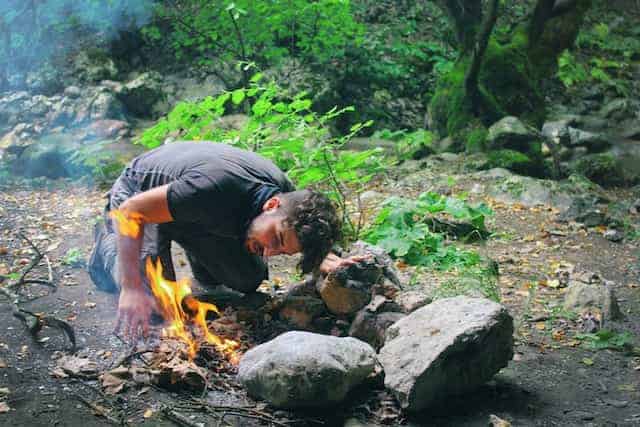
a. Introduction to survival camping
Survival camping is an extreme form of outdoor adventure that challenges your ability to survive in the wilderness with limited resources. This type of camping focuses on self-reliance, resourcefulness, and developing essential survival skills, such as shelter building, fire starting, and foraging for food and water.
b. The importance of wilderness survival skills
Developing wilderness survival skills is crucial for several reasons:
- Emergency situations: Being prepared for unexpected events, such as getting lost or injured, increases your chances of a successful outcome.
- Personal growth: Survival camping pushes you beyond your comfort zone, fostering personal growth and resilience.
- Connection with nature: Learning to survive in the wild deepens your connection to and understanding of the natural world.
c. Essential gear and equipment for survival camping
For survival camping, pack only the bare essentials, as the goal is to rely on your skills and ingenuity. Some basic items to include are:
- Knife or multi-tool: A versatile tool for cutting, carving, and other tasks.
- Fire starter: Waterproof matches, a lighter, or a ferrocerium rod for starting fires.
- Shelter materials: A tarp, emergency blanket, or lightweight bivy sack for protection against the elements.
- Water purification: A portable water filter or purification tablets to ensure safe drinking water.
- First aid kit: A compact kit with essential medical supplies.
d. Tips for planning a successful survival camping trip
To maximize the chances of a successful survival camping experience, follow these tips:
- Start small: Begin with shorter trips close to home to build your skills and confidence.
- Research the area: Understand the local terrain, climate, and potential hazards before setting out.
- Learn from experts: Take survival courses or read books by experienced survivalists to gain valuable knowledge.
- Practice skills: Regularly practice essential survival skills, such as fire starting, shelter building, and navigation.
- Inform others: Share your plans and itinerary with friends or family in case of an emergency.
e. Top survival camping destinations and experiences
Some survival camping experiences and destinations to consider include:
- Wilderness survival courses: Enroll in a course led by experts to learn essential skills and practice them in a controlled environment.
- National forests: Many national forests in the United States offer remote backcountry areas where you can test your survival skills.
- Appalachian Trail or Pacific Crest Trail: Sections of these long-distance trails provide challenging environments for survival camping.
- Alaska, USA: The vast wilderness of Alaska offers a range of survival camping opportunities, from coastal rainforests to rugged mountain terrain.
- Outback Australia: The remote and harsh landscapes of the Australian Outback present a unique and challenging survival camping experience.
Remember to prioritize safety and environmental responsibility while planning a survival camping adventure.
11. Horse Camping: Riding into the Wilderness
a. The joys of horse camping and its history
Horse camping combines the thrill of horseback riding with the joys of camping, allowing you to explore remote wilderness areas while bonding with your equine companion. Horse camping has a history dating back to the early days of exploration and cowboy culture; horse camping offers a unique and immersive outdoor experience that connects you to nature and tradition.
b. Preparing yourself and your horse for a camping trip
Before embarking on a horse camping adventure, follow these steps to ensure both you and your horse are prepared:
- Physical fitness: Make sure you and your horse are in good physical condition for the challenges of riding and camping.
- Training: Your horse should be comfortable with trail riding, crossing various terrains, and spending nights away from its familiar environment.
- Familiarization: Spend time camping with your horse close to home to help it adapt to the experience before venturing farther afield.
c. Essential gear and equipment for horse camping
When packing for a horse camping trip, include the following items:
- Riding gear: Helmet, riding boots, and appropriate clothing.
- Tack: Saddle, bridle, saddlebags, and other necessary equipment for your horse.
- Horse care items: Grooming supplies, feed, water buckets, and a portable corral or picket line.
- Camping gear: Tent, sleeping bag, cooking equipment, and other essentials for your comfort and safety.
d. Tips for finding horse-friendly campsites and trails
To locate suitable campsites and trails for horse camping, consider these suggestions:
- Research online: Websites and forums dedicated to horse camping and trail riding can provide valuable information about horse-friendly locations and trails.
- Contact local authorities: Reach out to the managing organizations of parks, forests, or wilderness areas to inquire about horse camping regulations and available facilities.
- Network with other horse campers: Connect with experienced horse campers to gather recommendations and learn from their experiences.
e. Horse camping safety and Leave No Trace principles
To ensure a safe and environmentally responsible horse camping experience, follow these guidelines:
- Monitor your horse’s health: Regularly check your horse for signs of injury, illness, or exhaustion, and be prepared to adjust your plans if needed.
- Carry a first aid kit: Bring a comprehensive first aid kit for both you and your horse, including items such as bandages, wound care supplies, and pain relievers.
- Practice Leave No Trace principles: Minimize your impact on the environment by packing out trash, using established campsites, and properly disposing of horse waste.
- Respect wildlife: Maintain a safe distance from wildlife and avoid disturbing their natural habitats.
- Follow local regulations: Adhere to trail rules and camping regulations specific to the area you’re visiting.
12. Car Camping: Convenience Meets Adventure
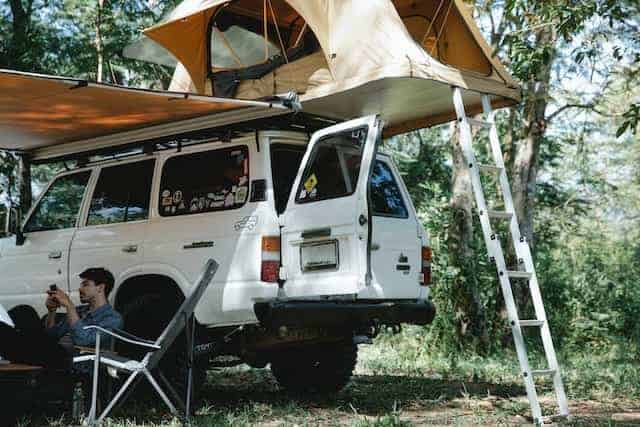
a. What is car camping and its advantages
Car camping is a popular form that involves using your vehicle as a base camp, allowing you to bring more gear and enjoy additional comfort while exploring the great outdoors. Some advantages of car camping include:
- Convenience: With your vehicle nearby, you can pack more items, such as a cooler, comfortable bedding, and cooking equipment.
- Accessibility: Car camping lets you explore a wide range of locations, from established campgrounds to remote backcountry spots.
- Weather protection: If unexpected weather arises, your vehicle serves as an emergency shelter.
- Family-friendly: Car camping is an excellent way for families and groups with varying fitness levels to enjoy the outdoors together.
b. Selecting the right vehicle and camping gear
To maximize your car camping experience, consider the following:
- Vehicle choice: Opt for a spacious vehicle with enough room for passengers and gear, such as a minivan, SUV, or station wagon.
- Sleeping arrangements: Decide whether you will sleep in a tent, in the vehicle itself, or use a rooftop tent.
- Comfort items: Bring along items that enhance your camping experience, such as camp chairs, a table, and cooking equipment.
c. Tips for finding car-friendly campsites
To locate suitable campsites for car camping, consider these suggestions:
- Research online: Websites and apps dedicated to camping can help you find car-accessible campsites and reviews.
- Contact local authorities: Reach out to the managing organizations of parks or wilderness areas to inquire about car camping regulations and available facilities.
- Network with other car campers: Connect with experienced car campers to gather recommendations and learn from their experiences.
d. Essential gear and equipment for car camping
When packing for a car camping trip, include the following items:
- Shelter: A tent, vehicle-based sleeping setup, or rooftop tent.
- Sleeping gear: Sleeping bags, pads, or air mattresses.
- Cooking equipment: A portable stove, cookware, utensils, and food storage containers.
- Lighting: Lanterns, flashlights, or headlamps for nighttime visibility.
- Emergency supplies: A first aid kit, vehicle repair tools, and a spare tire.
e. Car camping safety and etiquette
To ensure a safe and enjoyable car camping experience, follow these guidelines:
- Keep food secure: Store food in airtight containers or use bear-resistant food lockers in bear country.
- Respect quiet hours: Be mindful of noise levels, especially during designated quiet hours at campgrounds.
- Practice Leave No Trace principles: Minimize your impact on the environment by packing out trash, staying on designated trails, and respecting local regulations.
- Plan for emergencies: Carry a first aid kit, vehicle repair tools, and be prepared for changes in weather.
13. Bouldering and Climbing Camping: Merging Camping with Climbing Adventures
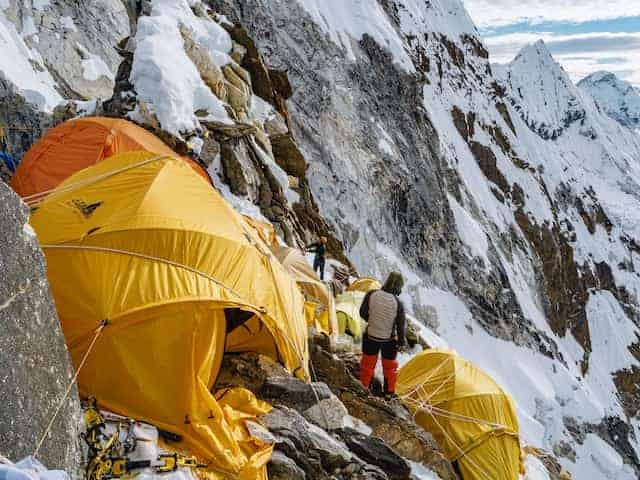
a. Merging camping with climbing adventures
Bouldering and climbing camping combines the excitement of rock climbing with the outdoor experience of camping, offering a thrilling and rewarding way to explore nature. By camping at or near climbing destinations, you can maximize your time on the rocks and immerse yourself in the climbing lifestyle.
b. Types of climbing and their respective camping styles
There are several types of climbing, each with its own camping style:
- Bouldering: Short, intense climbs on boulders, often requiring a crash pad for safety. Camping near bouldering areas allows for easy access and a relaxed atmosphere.
- Sport climbing: Routes with pre-placed bolts for protection, usually with a focus on difficult moves. Camping near sport climbing areas enables climbers to tackle multiple routes in a day.
- Traditional (trad) climbing: Routes requiring climbers to place their own protection in the rock. Camping near trad climbing areas can vary, from established campgrounds to remote backcountry sites.
c. Essential gear and equipment for climbing camping
In addition to standard camping gear, you’ll need the following items for climbing camping:
- Climbing equipment: Rope, harness, helmet, shoes, and other essentials, depending on the type of climbing.
- Protection: Carabiners, quickdraws, cams, nuts, or other gear specific to your climbing discipline.
- Crash pad (for bouldering): A portable foam pad to provide a safe landing surface during bouldering sessions.
- Guidebook or app: A climbing guidebook or app with detailed information on routes, grades, and access.
- First aid kit: A well-stocked first aid kit, including items specific to climbing-related injuries.
d. Top climbing camping destinations around the world
Explore some of the best climbing camping destinations worldwide:
- Yosemite National Park, California, USA: A mecca for trad climbers, with iconic routes like El Capitan and Half Dome and numerous campgrounds.
- Joshua Tree National Park, California, USA: Home to world-class bouldering and trad climbing, with a variety of camping options within the park.
- Rodellar, Spain: A sport climbing paradise with hundreds of routes and nearby camping facilities.
- Squamish, British Columbia, Canada: A renowned climbing destination offering trad, sport, and bouldering options, along with several camping areas.
- Fontainebleau, France: Known as the birthplace of bouldering, Fontainebleau offers thousands of boulder problems and a range of camping options.
e. Climbing safety and minimizing environmental impact
To ensure a safe and responsible climbing camping experience, follow these guidelines:
- Practice safe climbing techniques: Always double-check your gear, use proper communication, and know your limits.
- Buddy up: Climb with a partner or group for added safety and support.
- Learn from experienced climbers: Seek guidance from seasoned climbers or take a course to improve your skills and knowledge.
- Follow Leave No Trace principles: Minimize your impact on the environment by packing out trash, staying on designated trails, and respecting local regulations.
14. Winter Camping: Embracing the Cold and Snow
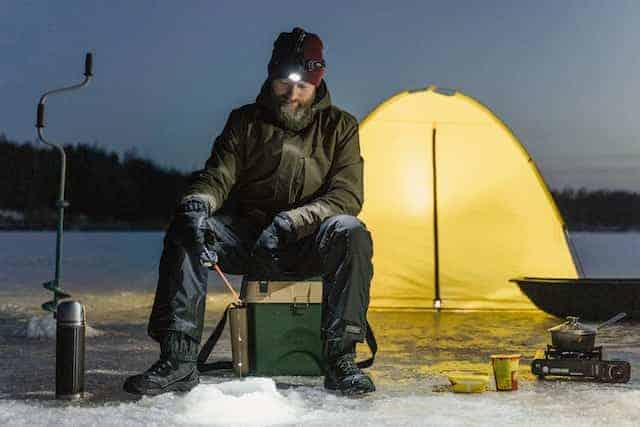
a. The allure of winter camping
Winter camping offers a unique and serene experience, allowing you to enjoy the beauty of snow-covered landscapes, crisp air, and the peacefulness of the season. It provides an opportunity to explore popular destinations without the crowds and witness winter’s transformative power on the natural world.
b. Types of winter camping
There are several types of winter camping to choose from, depending on your preferences and skill level:
- Cold weather tent camping: Camping in a four-season tent designed to withstand snow, wind, and cold temperatures.
- Snowshoe or cross-country ski camping: Trekking into the wilderness on snowshoes or skis and setting up camp in a remote location.
- Backcountry hut or yurt camping: Staying in a remote, rustic structure that provides basic shelter and amenities, often accessible only by snowshoeing, skiing, or snowmobiling.
c. Essential gear and equipment for winter camping
To ensure a safe and enjoyable winter camping experience, make sure to pack the following gear and equipment:
- Four-season tent: A durable tent designed to handle snow, wind, and cold temperatures.
- Insulated sleeping pad and sleeping bag: A high R-value sleeping pad and a sleeping bag rated for cold temperatures to ensure warmth and comfort.
- Layered clothing: A combination of moisture-wicking base layers, insulating mid-layers, and waterproof outer layers to help regulate body temperature and stay dry.
- Stove and fuel: A reliable stove and appropriate fuel designed for cold weather use.
- Navigation tools: A map, compass, or GPS device to navigate through snow-covered terrain.
d. Tips for a successful winter camping trip
Follow these tips to make your winter camping experience safe and enjoyable:
- Check weather and avalanche conditions: Stay informed about the weather and avalanche risks in the area you plan to camp.
- Learn cold-weather skills: Familiarize yourself with techniques for setting up camp, cooking, and staying warm in cold conditions.
- Stay hydrated and well-fed: Drink plenty of water and consume high-calorie foods to help your body maintain warmth and energy.
- Layer appropriately: Dress in layers to regulate your body temperature and avoid sweating, which can lead to hypothermia.
- Keep a positive attitude: Embrace the challenges and beauty of winter camping, and remember that attitude can greatly impact your experience.
e. Top winter camping destinations
Consider these winter camping destinations for a memorable experience:
- Yellowstone National Park, Wyoming, USA: Explore the park’s unique geothermal features, wildlife, and scenic landscapes blanketed in snow.
- Lapland, Finland: Experience the magical Arctic wilderness, with opportunities for dog sledding, snowshoeing, and viewing the Northern Lights.
- Banff National Park, Alberta, Canada: Discover the stunning beauty of the Canadian Rockies, with a variety of winter activities and camping options.
- Mount Tahoma Trails, Washington, USA: Enjoy a network of trails and backcountry huts nestled in the snow-covered forests near Mount Rainier.
- Jotunheimen National Park, Norway: Immerse yourself in the rugged beauty of Norway’s high mountains, with opportunities for ski touring and winter camping.
Remember to always prioritize safety and preparation when embarking on a winter camping adventure.
15. Tarp Camping: Minimalist Shelter in the Great Outdoors
a. Introduction to tarp camping
Tarp camping is a minimalist approach to shelter in the outdoors, using a simple tarpaulin (tarp) as protection against the elements. By pitching the tarp in various configurations, you can create a lightweight and versatile shelter that suits your needs and the environment.
b. Benefits of tarp camping and its minimalist approach
Some benefits of tarp camping include:
- Lightweight: Tarps are typically lighter than tents, making them ideal for backpacking or bikepacking trips.
- Versatility: Tarps can be set up in numerous configurations, adapting to different weather conditions and terrain.
- Ventilation: Tarp shelters provide better airflow than tents, reducing condensation and keeping you cooler in warm weather.
- Connection with nature: Tarp camping offers a more immersive outdoor experience, with fewer barriers between you and the environment.
c. Selecting the right tarp and accessories
When choosing a tarp for camping, consider the following factors:
- Material: Look for a durable, waterproof, and lightweight material like silnylon or Dyneema Composite Fabric (DCF).
- Size: Select a tarp that provides enough coverage for your needs, taking into account your desired setup and the number of people using the shelter.
- Accessories: Gather essential accessories like guylines, stakes, and trekking poles or sticks to pitch your tarp.
d. Tips for setting up a tarp shelter
Follow these tips for a successful tarp setup:
- Practice different configurations: Learn various tarp pitches, such as the A-frame, diamond, or C-fly, to adapt to different conditions and preferences.
- Choose your site wisely: Select a flat, well-drained area, avoiding low spots where water may pool. Take advantage of natural windbreaks and consider the direction of the wind.
- Use tensioning knots: Learn to tie adjustable knots, like the taut-line hitch, to maintain proper tension on your guylines.
e. Weather considerations and safety tips
When tarp camping, keep these weather and safety tips in mind:
- Check the weather forecast: Be aware of potential storms or extreme temperatures, and plan your shelter accordingly.
- Prepare for wind: Angle your tarp to deflect wind and stake it down securely to prevent it from blowing away.
- Avoid camping under deadfall: Be cautious of potential falling branches or trees when choosing your campsite.
16. Bivy Sack Camping: The Ultra-Lightweight Experience
a. What is bivy sack camping?
Bivy sack camping, or bivouac sack camping, involves using a lightweight, waterproof, and breathable cover that wraps around your sleeping bag, providing a minimalist shelter for a night in the outdoors. Bivy sacks are ideal for solo adventurers, climbers, or backpackers seeking a compact and lightweight shelter option that allows for quick and easy setup in various environments.
b. Benefits of bivy sack camping
There are several advantages to choosing bivy sack camping:
- Lightweight and compact: Bivy sacks are generally lighter and more packable than tents, making them perfect for ultralight backpacking or climbing trips.
- Versatility: Bivy sacks can be used in a wide range of settings, from high alpine environments to dense forests, and can be easily set up almost anywhere.
- Closer to nature: Sleeping in a bivy sack allows for a more intimate connection with the outdoors, offering unobstructed views of the night sky and surrounding landscape.
c. Choosing the right bivy sack for your adventure
When selecting a bivy sack, consider the following factors:
- Material: Look for a bivy made from waterproof, breathable materials that can handle condensation and keep you dry in wet conditions.
- Size: Ensure the bivy sack is large enough to accommodate your sleeping bag and pad comfortably.
- Weight: Ultralight options are ideal for those seeking to minimize pack weight, but may sacrifice durability or weather protection.
- Ventilation: Opt for a bivy sack with proper ventilation features, such as mesh panels or adjustable hoods, to reduce condensation and improve airflow.
d. Tips for a successful bivy sack camping experience
To make the most of your bivy sack camping adventure, follow these tips:
- Practice setting up your bivy sack before your trip to become familiar with its features and setup process.
- Choose a flat, sheltered location to set up your bivy sack, avoiding areas prone to flooding or pooling water.
- Use a groundsheet or tarp underneath your bivy sack to protect it from punctures and abrasions.
- Keep your gear organized and protected from the elements by using a waterproof stuff sack or pack liner.
e. Safety and weather considerations
While bivy sack camping offers many benefits, it’s essential to be mindful of potential safety concerns and weather considerations:
- Weather protection: Bivy sacks are generally less protective than tents in extreme weather conditions, so be prepared to seek additional shelter if necessary.
- Condensation management: Bivy sacks can be prone to condensation, so choose a well-ventilated option and air it out during the day.
- Wildlife: Sleeping in a bivy sack can make you more vulnerable to wildlife encounters, so be aware of your surroundings and follow local guidelines for food storage and safety.
- Terrain and exposure: Be cautious when choosing a bivy sack camping location, avoid avalanche-prone areas, and seek shelter from the wind.
With careful planning and consideration, bivy sack camping can be a rewarding and unique outdoor experience that brings you closer to nature.
17. Motorcycle Camping

Motorcycle camping combines the freedom and adventure of exploring the open road with the excitement and beauty of camping. It allows you to experience the great outdoors in a way that is not possible with other modes of transportation. The experience of feeling the wind in your hair, taking in the breathtaking scenery, and setting up camp in a remote location is a thrill that cannot be matched.
Choosing the right motorcycle for your camping adventure
When it comes to motorcycle camping, choosing the right motorcycle is crucial. Here are some things to consider:
- Comfort: Make sure your motorcycle is comfortable for long rides, as you’ll likely be spending several hours on the road.
- Storage: Look for a motorcycle with adequate storage space to carry your camping gear and supplies.
- Fuel efficiency: Choose a motorcycle with good fuel efficiency to save money and reduce the number of stops you need to make for gas.
- Durability: Opt for a durable motorcycle that can handle rough terrain and unpredictable weather conditions.
By taking these factors into account, you can choose a motorcycle that is well-suited for your camping adventure and ensure a safe and enjoyable trip.
18. Truck Camping

Truck camping is a form of camping where you sleep in the bed of a pickup truck rather than a traditional tent or recreational vehicle. It offers more mobility and flexibility than car camping, as you can easily drive to remote locations and sleep comfortably in the back of your truck. Additionally, it can provide a unique camping experience for those who love the outdoors but prefer not to sleep on the ground.
Tips for finding the right truck camping site
Finding the right truck camping site can make all the difference in your camping experience. Consider these tips when searching for a site:
- Look for dispersed camping areas: Many public lands, such as national forests, allow for dispersed camping in remote areas that can be accessed by a high-clearance vehicle.
- Check with local land management agencies: Contact the local Bureau of Land Management or Forest Service office to find out about camping restrictions and regulations.
- Use online resources: Websites such as freecampsites.net and Campendium can help you find free, low-cost camping options in your desired location.
Remember to always follow Leave No Trace principles and practice responsible camping habits when truck camping.
19. Beach Camping

Beach camping is a unique and thrilling way to experience the great outdoors while enjoying the sun, sand, and surf. It involves setting up camp on or near the beach and spending your days relaxing, swimming, and exploring the shoreline.
One of the best things about beach camping is that it allows you to combine camping with a beach vacation, so you can have the best of both worlds. Imagine waking up to the sound of waves crashing on the shore and stepping out of your tent to feel the sand between your toes. It’s an unforgettable experience that’s hard to beat.
Tips For Beach Camping
- Choose the right beach: Not all beaches are suitable for camping, so make sure to do your research and choose a beach that allows camping and has the facilities you need, such as restrooms and showers.
- Check the weather: Beach camping is heavily dependent on the weather, so make sure to check the forecast before you go and be prepared for any changes in conditions.
- Pack the right gear: Beach camping requires specific gear, such as a beach tent or shelter, sand stakes, and a beach mat or towel. Don’t forget sunscreen, bug spray, and plenty of water, too.
- Follow Leave No Trace principles: As with any form of camping, it’s important to minimize your impact on the environment. Follow Leave No Trace principles, pack out all trash, and avoid disturbing wildlife and vegetation.
- Be aware of tides and currents: The ocean can be unpredictable, so be aware of tides and currents when setting up camp and swimming. Stay safe by following posted warnings and guidelines.
With proper planning and preparation, beach camping can be an amazing experience that you’ll never forget. So pack your sunscreen and swimsuit and head to the beach for your next camping adventure!
20. Dry Camping
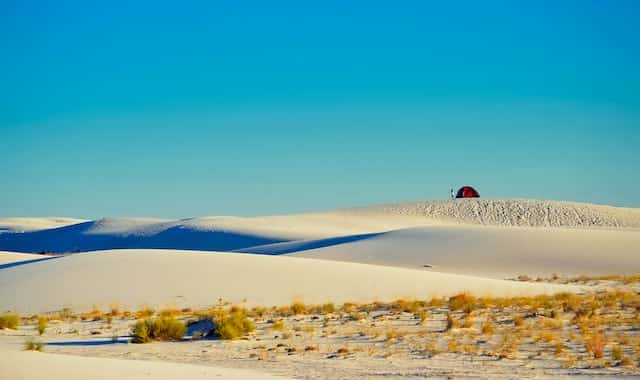
Dry camping is a type of camping where you camp without any hookups for water, electricity, or sewage. This type of camping is also called boondocking, and it can be a fun and challenging way to get off the beaten path and experience nature.
Some tips for a successful dry camping trip:
- Planning: Before embarking on a dry camping trip, it’s essential to plan out your route and make sure you have enough supplies. Consider bringing extra water and fuel, as well as a backup generator or solar panels for electricity.
- Choosing a site: Look for designated dry camping sites in national forests, BLM land, or state parks. These sites usually have a flat spot for your RV or tent and may have a fire ring or picnic table. Make sure to check the rules and regulations for each site before camping.
- Water conservation: Since you won’t have access to water hookups, it’s important to conserve water during your trip. Use biodegradable soap for dishes and body washing, and consider using a solar shower bag to clean yourself. Use paper plates and disposable utensils to reduce water usage during clean up.
- Power conservation: Without electric hookups, you’ll need to conserve your battery and generator power. Use LED lights instead of incandescent bulbs, turn off all electronics when not in use, and consider using a propane-powered fridge instead of an electric one.
- Waste management: Since you won’t have a sewage hookup, you’ll need to manage your waste properly. Use a portable toilet or dig a hole for human waste, and pack out all trash and waste in designated garbage bags. Remember to practice Leave No Trace principles and leave the campsite as you found it.
21. Indoor Camping

Indoor camping is a type of camping where you set up a tent or other camping gear inside a building or other enclosed space, such as a garage, basement, or living room. It’s a fun and creative way to enjoy the camping experience without having to brave the elements, making it an ideal option for those who prefer to stay indoors or want to try camping for the first time.
Indoor camping can take many forms, ranging from a simple tent pitched in your living room to a more elaborate setup with hammocks, sleeping bags, and campfire-themed decorations. It’s a great way to spend quality time with family and friends, host a sleepover, or add a bit of adventure to a rainy day.
Tips for a successful indoor camping experience
- Set the scene: Use camp-themed decorations such as string lights, lanterns, and fake campfires to create a cozy and authentic atmosphere.
- Unplug and unwind: Turn off electronics and disconnect from the outside world to fully immerse yourself in the camping experience.
- Embrace the fun: Don’t be afraid to be silly and have fun with your indoor camping setup. Play games, tell stories, and make s’mores to truly capture the spirit of camping.
22. Festival Camping

Festival camping is a type of camping that involves camping at a festival or outdoor event, such as a music festival or art fair. This type of camping is popular among people who want to experience the festival atmosphere while also enjoying the great outdoors. It allows festival-goers to stay on-site, giving them the freedom to fully immerse themselves in the festivities.
Preparing for a festival camping trip
When preparing for a festival camping trip, consider the following:
- Choose the right festival: Research the festival ahead of time to ensure it aligns with your interests and preferences.
- Check the camping policies: Determine the festival’s camping policies, including what kind of camping gear is allowed and any restrictions on campfires or cooking equipment.
- Pack for the weather: Check the forecast and pack accordingly, including rain gear and warm layers for cold nights.
- Bring comfortable gear: Comfortable camping gear, such as a sturdy tent, cozy sleeping bag, and comfortable camping chair, can make all the difference in your festival experience.
- Plan for food and drink: Some festivals provide food and drink vendors, while others require festival-goers to bring their own supplies.
- Be respectful of others: Keep the noise down at night, dispose of trash properly, and be respectful of your camping neighbors.
Conclusion
To wrap it up, camping is truly an incredible and diverse adventure that caters to everyone’s taste. You know, there’s just something magical about it all. Like that time my friends and I pitched a tent under a star-filled sky, sharing stories and roasting marshmallows around the crackling campfire. Or when I decided to try horse camping for the first time – I can’t describe the feeling of galloping through the wilderness, completely in sync with my four-legged friend.
So whether you’re into the classic tent experience or feeling a bit daring and want to explore backpacking or horse camping, the great outdoors has endless opportunities to create unforgettable memories. Trust me, once you give it a try, you’ll be hooked! So come on, let’s release our inner explorers and venture into the wild world of camping – it’s an adventure you won’t want to miss.

Michael is heavily inclined towards traveling to natural places and documenting cultures/people from different parts of the world. He also loves hiking and camping and is spirited toward all outdoor activities. He will share his passion for outdoor life and brands or products we use outside our homes. He has good research skills, and that’s why you can see why his articles are packed with info that is factual and not readily available. He also has the vision to travel the whole world and share it with all readers of Outdoor Favor.

